Introduction
Since 1976 I have enjoyed a unique and highly successful technique I discovered for catching white bass. I know - everyone thinks his technique is the best, but in 33 years of observations out on the lakes, I have not seen anyone using a technique as productive as this one. It's a technique that works throughout the day and catches fish when other methods fail. I've taught friends and family how to use it and now want to pass it on for others' enjoyment while I am still able
History and Background
It was the summer of 1976, and I had taken my father-in-law, Ray Fowler, on a white bass fishing outing on Lake Livingston in southeast Texas. We were after some of the large whites that hang out on the old 190 roadbed that crosses the mid-lake area.  We had become pretty adept at catching whites by bumping the lake bottom with white, yellow and silver slabs and silver spoons. But on this day we were to discover what turned out to be a vastly superior method for catching white bass - a method that I have enjoyed and taught to others ever since.
We had become pretty adept at catching whites by bumping the lake bottom with white, yellow and silver slabs and silver spoons. But on this day we were to discover what turned out to be a vastly superior method for catching white bass - a method that I have enjoyed and taught to others ever since.
I had become an avid white bass fishing fan back in 1967. That's when I returned from Viet Nam and spent a month getting reacquainted with my wife and enjoying some R&R before reporting back from military leave with my former employer. We spent that month at my wife's parents' place on Eagle Mountain Lake northwest of Ft. Worth. Fishing had been a lifelong interest of mine, so when my wife's Uncle Charlie, who lived next door, invited me to go white bass fishing, I jumped at the chance. I had never caught a white bass before - only bluegill, white perch, black bass, drum and catfish.
Uncle Charlie was a crusty old retired beef-boner and union boss for Swift and Company and had lived on Eagle Mountain Lake since the 1940's. He was a big, strong man who didn't say much, but was one of those guys who could do just about anything he set his mind to. That day we headed out from his dock in his 14-foot aluminum boat with a 10 hp engine and began cruising the lake for schooling white bass. Back then we didn't have depth finders or fish locators, so the primary way to locate whites was looking for surface action - either seeing the fish feeding at the surface or seeing gulls diving after the surfacing shad at a distance or looking for a congregation of boats. Once you find a school feeding on the surface, you can throw almost anything at them and catch fish.
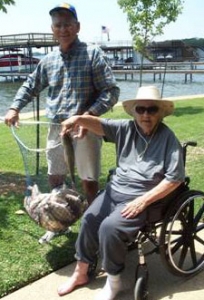 During that month and on vacations over the next few years, I caught a lot of schooling whites fishing with Uncle Charlie. He also had a back-up plan in case we didn't find any surface feeding fish. He had learned over the years that you could catch whites fishing over certain humps and points by bumping the bottom with spoons and slabs. He had to rely on landmarks and triangulation to locate the structures, and from experience he was very good at locating his spots. However, without a fish locator there was a lot of wasted time trying to find fish this way - you had to stop and fish each structure to see if fish were there. So we always tried to locate them on the surface before resorting to this more tedious approach.
During that month and on vacations over the next few years, I caught a lot of schooling whites fishing with Uncle Charlie. He also had a back-up plan in case we didn't find any surface feeding fish. He had learned over the years that you could catch whites fishing over certain humps and points by bumping the bottom with spoons and slabs. He had to rely on landmarks and triangulation to locate the structures, and from experience he was very good at locating his spots. However, without a fish locator there was a lot of wasted time trying to find fish this way - you had to stop and fish each structure to see if fish were there. So we always tried to locate them on the surface before resorting to this more tedious approach.
By 1976 I had gotten pretty proficient at catching whites using slabs. I had bought my own boat in 1974 and, living in Houston, the nearest good place for white bass was Lake Livingston about 100 miles away. The first two trips to Livingston were strikeouts. Then on an outing with my parents in the summer of 1974 we found acres of surface schooling whites, and they were large - in the two-pound range. We ended up with 175 fish in about 3 hours (there was no limit on whites back then so we kept and cleaned them all). However, after numerous trips to Livingston, we learned that trying to find surface schooling fish was unreliable. We also learned about the Old 190 Highway roadbed - how the structure attracted whites - and so we began fishing it. By this time we had depth finders - the flasher type - and that made it easier to locate the roadbed as well as to see fish just off the bottom.
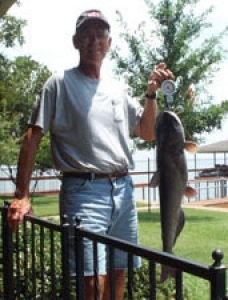
The Discovery
Back to the beginning of this story, my father-in-law and I were fishing the Old 190 roadbed with slabs and were having only mild success. Another popular way to catch whites is to troll for them, and several trollers were out that day. They would troll up and down the roadbed swinging around the occasional anchored boats, which were slabbing for whites (as we were) or catfishing. Though I personally don't care for it (it seems boring), trolling for whites can be very effective. On this particular day, I noticed that every time this one boat trolled over the section of roadbed where we were slabbing they would catch a nice white. I would slab the section again after they were out of the way, and I wouldn't get a hit. Obviously, white bass were down there because the trollers kept catching them. But, working slabs in the same area produced little.
This observation led me to discover the new, much more effective method. How could I cast a lure and emulate what the troller was doing? The trolling action must look like a shad or minnow swimming steadily through the water near the bottom. I opened my tackle box to see what I had that would look like a swimming minnow. My eye went to a silver #2 Mepps Aglia spinner I had bought for trout fishing in Wyoming. So I tied it on and cast it to the area where the troller had been picking up fish. I took up the slack and cranked the spinner up from the bottom, and, sure enough, I immediately caught a nice white. A second cast produced another white. I searched my tackle box, found another Mepps and put it on my father-in-law's line, and he too started catching whites. If we didn't get a fish after cranking the reel 6 to 8 turns we would stop, release the line, and let the spinner free-fall back to the bottom, then take up the slack and crank it 6 to 8 turns again, repeating this all the way back to the boat. We ended up with a nice bunch of fish that day, but more than that, I had made the fishing discovery of my lifetime.
Verification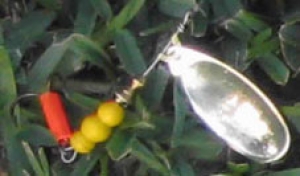
For months afterward on my fishing outings I would rig one rod up with a slab or spoon and another up with a Mepps spinner. I wanted to verify the new technique. There was no comparison. Sometimes I could catch fish with the slab, but I could always catch more and catch them faster with the Mepps spinner. Now convinced, I taught my relatives and friends the new technique. It became so reliable that we stopped chasing surface schooling whites altogether, preferring to find them on a structure, mark them, and anchor or use a trolling motor to stay on the fish. We discovered that with this approach we did not have to get up at the crack of dawn - we could locate fish any time of the day and catch them. Throughout the late 70's, the 80's, and 90's we primarily fished Lake Livingston, and many a day we'd be pulling fish in every cast and be surrounded by boats attracted by our success. They would all be slabbing but catching few if any.
Effective in Various Lakes and Reservoirs
have taken the technique to other Texas lakes, and it is successful everywhere I try it. I took it back to Eagle Mountain Lake. I fish it on Cedar Creek Lake, where I now live. I've fished it in Richland Chambers Reservoir, Lake Limestone, Lake Whitney, Lake Buchanan, Lake Tawakoni and Lake Waco.
Catches Multiple Varieties of Fish
Another enjoyable aspect of this method is that it catches a wide variety of fish. Although I go looking for and catch mostly whites, in with them we routinely catch catfish (blue, channel and opelousas), hybrids, stripers, black bass, crappie, yellow bass, drum and buffalo. For example I've caught many cats above 10 pounds, with the largest (a blue) going 40 and an op going 37. I've caught several buffalo in the 15 to 20 pound range, blacks up to 7 pounds, many 22 to 27 inch hybrids and several 5 to 6 pound drum. All of these were caught on a Mepps spinner while structure fishing for whites on Texas lakes.
About Mepps
Why a Mepps spinner? All I can say is that I've tried many others, and, I consistently did much better with Mepps - but not just any Mepps. They make a variety, and I've tried many of them. The one that works and the one I've used since 1976 is the silver Aglia plain - no skirt (see picture above). White and yellow bladed Mepps also work well. I use sizes 2,3,4 and 5 with 4 being the best all-around size. However, when fish are feeding on small shad, downsizing to a 2 is required. When using a 2 or 3 I use a pinch-on weight up about 13 inches from the bait to get it down to the bottom faster. Two of my fishing buddies separately decided to make copies of the Mepps Aglia, and both gave me some to try. Neither they nor I could reproduce the results we got with the Mepps. I can't explain it - I just accept it and keep a stock of Mepps on hand.
Perfecting the Technique
Over the years I've found that, to optimize results, each time you go fishing you have to experiment with three factors: speed of retrieval, length of retrieval before stopping and letting it fall back to bottom, and angle of retrieval, i. e. more lateral or vertical on the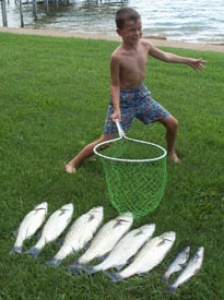 retrieve. Most of the time it doesn't matter - just start it up from the bottom and they hit it. At other times they want a very slow retrieval and will not follow it up more than a foot or two from the bottom. Sometimes burning it up fast on a long vertical retrieve works best. Then again, sometimes they want it pulled almost sideways along the bottom. When the fish are finicky, I'll make long casts and work the Mepps back to the boat using a combination of these variations until I can tell which gets the most strikes.
retrieve. Most of the time it doesn't matter - just start it up from the bottom and they hit it. At other times they want a very slow retrieval and will not follow it up more than a foot or two from the bottom. Sometimes burning it up fast on a long vertical retrieve works best. Then again, sometimes they want it pulled almost sideways along the bottom. When the fish are finicky, I'll make long casts and work the Mepps back to the boat using a combination of these variations until I can tell which gets the most strikes.
Just how productive can this technique be? Last month (May 2009) two fishing buddies and I, mostly fishing alone but sometimes together or with one or two guests, caught over 2000 including over 1700 whites, almost 80 keeper hybrids (most over 20 inches) and about 100 catfish. On one afternoon outing one buddy fishing alone caught 84 including 18 hybrids 21 to 24 inches. On another afternoon by himself he caught 140 including 133 whites and 3 keeper hybrids (Note: we do mostly catch and release). In these two examples all the fish were caught bottom fishing using the Mepps technique on humps that were 20 or more feet deep.
Testimonials from some who have learned the technique
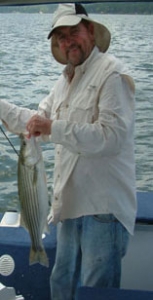 "I started using Mepps spinners with Dennis over 30 years ago. Since that time, I have only used Mepps. My tackle box is a small plastic box with spare #3 and #4 Mepps Aglia, plain, chrome spinners and split shots. The precision of the Mepps makes the retrieve much easier than any other bait." Randall Lovelace (Lake Livingston for 35 years)
"I started using Mepps spinners with Dennis over 30 years ago. Since that time, I have only used Mepps. My tackle box is a small plastic box with spare #3 and #4 Mepps Aglia, plain, chrome spinners and split shots. The precision of the Mepps makes the retrieve much easier than any other bait." Randall Lovelace (Lake Livingston for 35 years)
"My big brother, Dennis Christian, introduced our family to the Mepps Aglia #2 spinner about 30 years ago. Prior to that, we had been catching most of the white bass on slabs and spoons. But the Mepps spinners -- numbers 2, 3 and 4 -- along with the technique taught to us by Dennis, have yielded much success, no matter in which of the Texas lakes we are fishing." Dee Potcinske
"My experience using a Mepps Spinner began about 9 years ago when Dennis introduced me to the bait and his technique for using it to catch White Bass. The technique ... has resulted in me catching many hundreds of fish more than I had previously caught using other baits and other techniques...it also allows a person to catch almost every other species of fish such as Hybrid White Bass, Yellow Bass, Black Bass, Crappie, Catfish, Drum and an occasional Carp. ...recommend this bait and technique to anyone who likes to fish at any time of the day." Ed DeLoach
"I learned this from Dennis 2 years ago and I now use it exclusively. I always caught sand bass before (slabs) BUT I have caught twice as many using this method. I am now making baits to be used in this system. I am convinced that it is the system more than the bait that gets the fish." Leroy Carroll
Closing Thoughts
Although I have read where the Mepps Aglia is well known for being effective for whites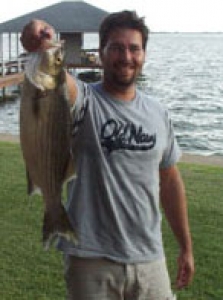 during spring spawns in the moving waters of creeks and rivers, using them for bottom fishing on structure out on the open water on lakes is apparently a truly unique technique. In my 30+ years of using the Mepps technique, I have only encountered one other person out on the lakes using it who, so far as I knew, was not someone my friends, family or I had taught. I asked him where he learned of the technique and he gave me the name of one of my work buddies whom I had taught a few years before.
during spring spawns in the moving waters of creeks and rivers, using them for bottom fishing on structure out on the open water on lakes is apparently a truly unique technique. In my 30+ years of using the Mepps technique, I have only encountered one other person out on the lakes using it who, so far as I knew, was not someone my friends, family or I had taught. I asked him where he learned of the technique and he gave me the name of one of my work buddies whom I had taught a few years before.
Today, I am retired and enjoying outstanding fishing on Cedar Creek Lake. I derive a great deal of satisfaction teaching others - like my grandsons and neighbors - how to use the Mepps technique. It is such an effective and easy-to-use technique, I wanted to relate it to others who love to fish while I am still able - hence, this article. I hope you try it and join me in experiencing the pure joy of catching lots and lots of fish!
disclosure Statement: As of this writing the author is not and has never been associated either directly or indirectly with the company that makes Mepps. Neither does the author know anyone who works for the company nor has he ever had any communications with the company or any of its representatives.


 Edited
Edited